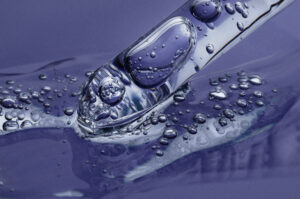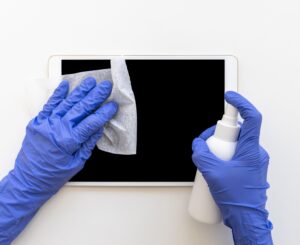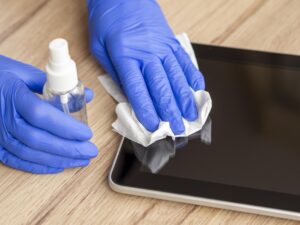Introduction
5 ways to Lubricate Your Laptop Screen. Your laptop screen is one of the most delicate and frequently touched parts of your device. Over time, it accumulates dirt, dust, and fingerprints, leading to a rough texture and, in some cases, a less responsive display. While most people focus on cleaning their screens, lubrication is rarely considered. However, keeping your screen smooth can improve usability and extend its lifespan, especially for touch-enabled laptops.
Lubricating your laptop screen doesn’t mean applying thick oils or greasy substances. Instead, it involves using gentle, safe solutions that help maintain a smooth sur
face without causing damage. Using the wrong type of lubricant can result in a sticky or greasy screen, which attracts even more dust and dirt. In this guide, we will explore five safe and effective ways to lubricate your laptop screen, ensuring it remains clean, responsive, and free from unnecessary friction.
1. Use a Microfiber Cloth and Screen Cleaner
1 of 5 Ways to Lubricate Your Laptop Screen.
Before considering any form of lubrication, cleaning your laptop screen is the first and most crucial step. Many times, what feels like a “rough” screen is just built-up dirt, oils from your finger
s, or dust. Using a microfiber cloth and a screen-friendly cleaning solution can restore the screen’s smoothness without the need for additional lubrication.
Microfiber cloths are soft and designed to pick up dirt and debris without scratching delicate surfaces. Unlike regular cloths or tissues, they do not leave lint or streaks behind. When paired with a screen-safe cleaning solution, they work wonders in restoring the screen’s original texture. A gentle wipe in circular motions effectively removes grime and ensures an even application of the cleaning solution.
When cleaning, it is essential to spray the solution onto the microfiber cloth rather than directly onto the screen. This prevents excess liquid from seeping into the edges of the screen, where it can damage internal components. Once wiped clean, allowing the screen to dry naturally ensures that no residue is left behind. Regular cleaning, ideally once a week, can reduce the need for additional lubrication while keeping the screen clear and free of smudges.
2. Apply a Silicone-Based Lubricant (With Caution)
2 of 5 Ways to Lubricate Your Laptop Screen.
If your laptop screen still feels rough after a thorough cleaning, using a silicone-based lubricant can help. These lubricants are widely used in electronics because they create a smooth finish without leaving an oily or greasy residue. Silicone lubricants are non-conductive, making them safe for electronic surfaces.
To apply a silicone-based lubricant, start by putting a small drop onto a microfiber cloth rather than directly on the screen. Using gentle, circular motions, spread the lubricant evenly across the screen. This creates a thin protective layer that enhances smoothness and reduces friction. Once applied, any excess should be wiped away with a clean, dry section of the microfiber cloth to avoid streaking.
It is important to use only a minimal amount of lubricant, as excess application can cause the screen to become slippery or attract dust. Testing a small, inconspicuous area before applying it to the entire screen ensures that the lubricant does not interfere with the display’s clarity or touch sensitivity. When done correctly, this method can improve touchscreen responsiveness and prevent smudging.
3. Use Petroleum Jelly or Mineral Oil (Sparingly and Carefully)

3 of 5 Ways to Lubricate Your Laptop Screen.
Although unconventional, petroleum jelly or mineral oil can serve as a temporary solution for lubricating a laptop screen. These substances create a thin barrier that enhances the smoothness of the screen while preventing dust buildup. However, they must be used sparingly, as excessive application can leave a greasy residue that attracts more dirt.
To apply, take a cotton pad and lightly dab a very small amount of petroleum jelly or mineral oil. Rubbing the cotton pad gently over the screen ensures that the lubricant spreads evenly. After application, buffing the screen with a clean microfiber cloth helps remove excess oil and prevents the screen from feeling sticky.
While this method is effective, it should not be used frequently. Over time, petroleum jelly and mineral oil can create a buildup that may require stronger cleaning solutions to remove. If the screen becomes overly greasy, wiping it down with a dry cloth or a mild screen cleaner can restore balance. As with any lubrication method, keeping these substances away from the edges of the screen and laptop ports is essential to prevent internal damage.
4. Use Commercial Screen Conditioning Wipes
4 of 5 Ways to Lubricate Your Laptop Screen.
For those looking for a convenient and mess-free way to lubricate their laptop screen, commercial screen conditioning wipes are a great option. These wipes are pre-moistened with a specialized cleaning and conditioning solution designed specifically for electronic displays. They not only clean the screen but also leave behind a subtle layer of lubrication that enhances smoothness and prevents static buildup.
Using screen conditioning wipes is straightforward. With the laptop turned off, gently wipe the screen in circular motions, ensuring even coverage. The wipes are designed to dry quickly without leaving behind streaks or excess residue. This makes them a hassle-free alternative to liquid lubricants, reducing the risk of over-application.
When selecting screen wipes, it is important to choose those that are alcohol-free and ammonia-free, as harsh chemicals can degrade the screen’s protective coatings. Many reputable brands offer wipes specifically designed for touchscreens, ensuring compatibility with laptop displays. For best results, using these wipes once or twice a week can maintain a consistently smooth screen.
5. Try Natural DIY Lubrication Methods

5 of 5 Ways to Lubricate Your Laptop Screen.
For those who prefer natural alternatives, there are a 5 Ways to Lubricate Your Laptop Screen Safely without causing harm. One of the simplest and safest options is aloe vera gel. Aloe vera has natural hydrating and anti-static properties that prevent dust buildup and improve screen texture. Applying a small amount to a microfiber cloth and gently rubbing it onto the screen can create a smooth, non-greasy surface.
Another effective DIY method involves a mixture of distilled water and white vinegar. By combining equal parts of both, a natural screen-cleaning and conditioning solution can be created. This mixture can be lightly applied with a microfiber cloth, ensuring that excess liquid does not seep into the edges of the laptop. Unlike harsh chemical cleaners, this solution is gentle and safe for most laptop screens.
Some users have even reported success using the inside of a banana peel to polish their screens. Rubbing the peel lightly over the screen before buffing with a clean cloth can enhance shine and remove minor smudges. While unconventional, these natural alternatives offer an eco-friendly approach to maintaining a laptop screen’s smoothness. These are the 5 Ways to Lubricate Your Laptop Screen Safely
Conclusion
5 Ways to Lubricate Your Laptop Screen Safely. A smooth and well-maintained laptop screen not only enhances the visual experience but also improves touch responsiveness and reduces glare. While cleaning with a microfiber cloth and a screen-friendly solution is the safest and most recommended method, additional lubrication techniques can further enhance the screen’s feel.
Silicone-based lubricants, when applied correctly, can create a non-greasy protective layer that improves screen interaction. Petroleum jelly and mineral oil, though effective, should be used sparingly to avoid buildup. Commercial screen conditioning wipes provide an easy-to-use option, while natural DIY methods like aloe vera or vinegar solutions offer chemical-free alternatives.
Regardless of the method used, it is important to avoid over-application and always test in a small area first. By incorporating proper cleaning and occasional lubrication into your laptop maintenance routine, you can ensure a long-lasting and responsive screen.
For keyboard related tips check out our new website : https://systemsurgeons.online/top-5-loudest-keyboard-switches-easy-guide-you-need-to-know/
FAQs
- Can I use WD-40 on my laptop screen?
No, WD-40 is too harsh for screens and can damage protective coatings. - Will lubricating my screen improve touch sensitivity?
Yes, reducing friction can enhance touchscreen responsiveness and usability. - What should I do if my screen becomes greasy after lubrication?
Use a clean microfiber cloth to buff away excess lubricant until the screen feels smooth. - Can I use baby oil to lubricate my screen?
No, baby oil is too thick and can leave a sticky residue that attracts dust. - How often should I lubricate my laptop screen?
It depends on usage, but generally, once every few weeks is sufficient. Regular cleaning can reduce the need for lubrication.


